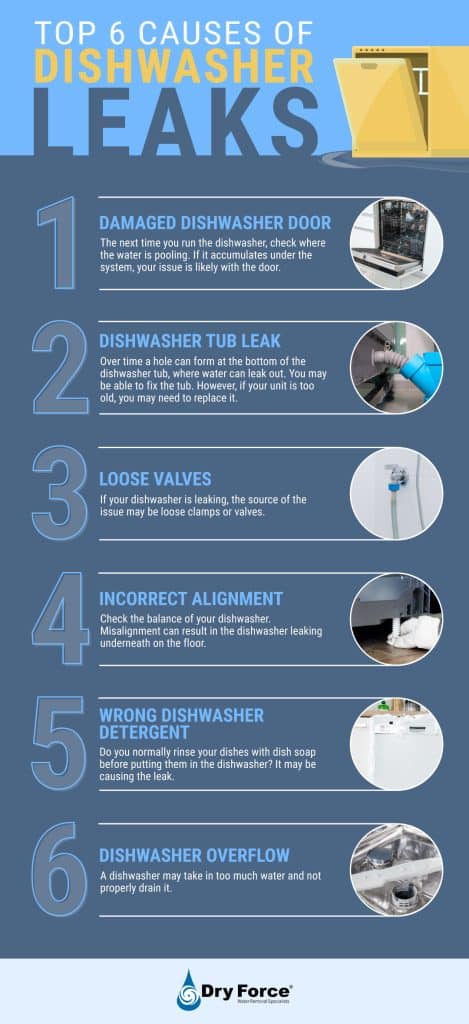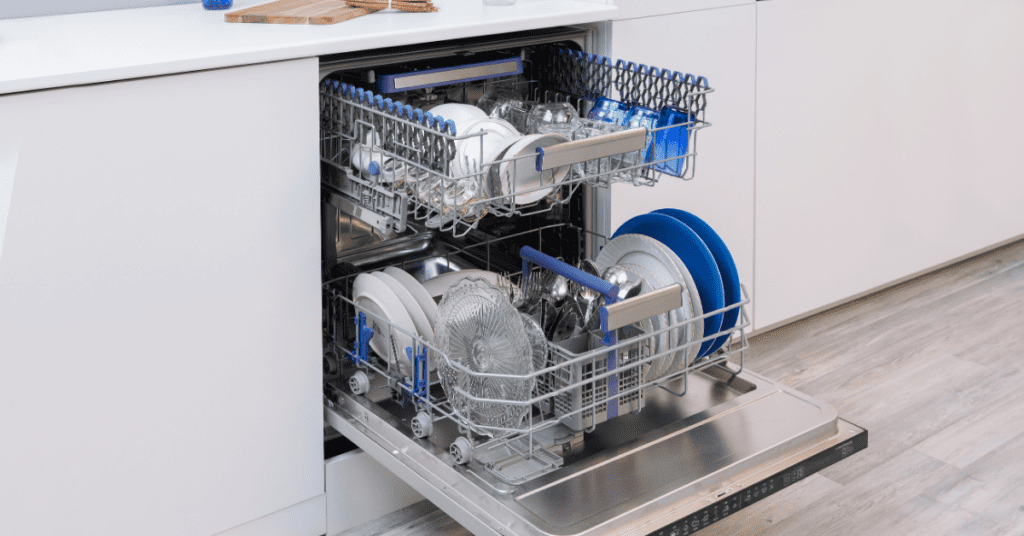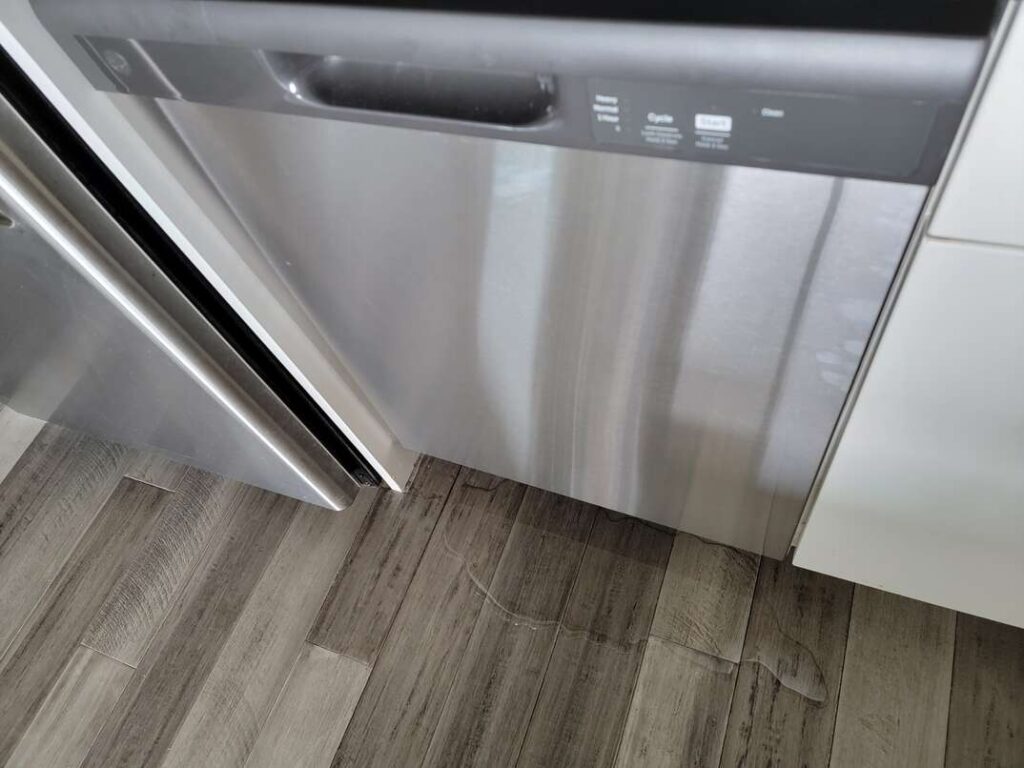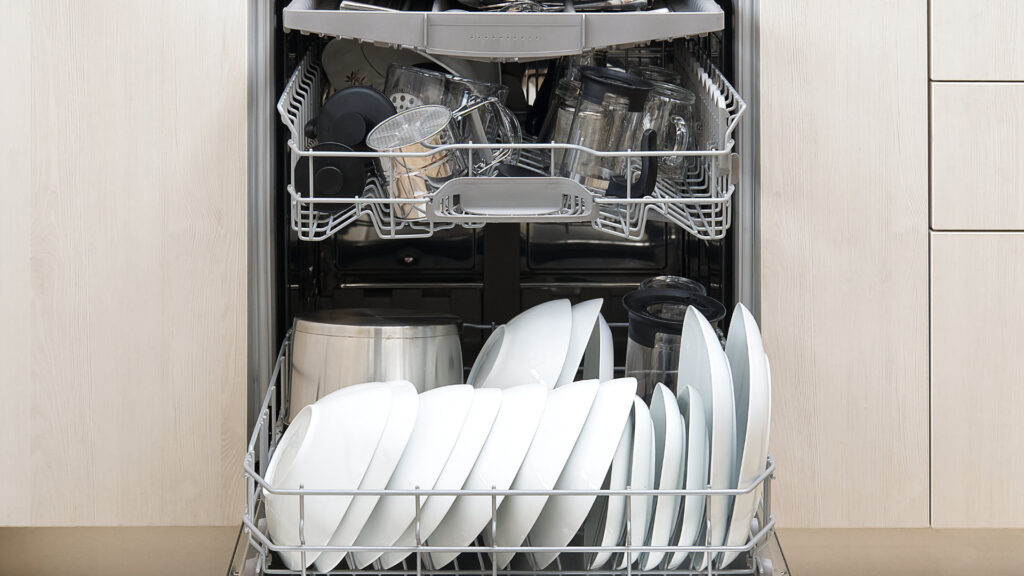
If you’re tired of dealing with a leaking dishwasher, we’ve got you covered! In this article, you’ll find practical tips and tricks to help prevent and resolve dishwasher leaking problems. Whether you’re a DIY enthusiast or someone who prefers to leave repairs to the professionals, these simple yet effective solutions will have your dishwasher leak-free in no time. Say goodbye to soggy kitchen floors and hello to worry-free dishwashing!

This image is property of dryforcecorp.com.
Regular Maintenance
Regular maintenance is essential for keeping your dishwasher in optimal condition and preventing any potential leaks. By performing these simple tasks on a regular basis, you can ensure that your dishwasher functions efficiently and avoid costly repairs in the future.
Check the door gasket
The door gasket is the rubber seal that runs along the edges of your dishwasher’s door. Over time, it can become worn or damaged, leading to leaks. To prevent this, inspect the door gasket regularly for any signs of wear or tear. If you notice any cracks or gaps, it’s time to replace the gasket.
Inspect the spray arms
The spray arms are responsible for distributing water throughout the dishwasher during a cycle. Over time, they can become clogged with debris or develop cracks, causing leaks. Regularly check the spray arms for any clogs or damage. If you spot any issues, clean the spray arms thoroughly or consider replacing them if necessary.
Clean the filter
The filter in your dishwasher plays a crucial role in trapping food particles and preventing them from clogging the drain. However, if the filter becomes dirty or clogged, it can impede the flow of water and cause leaks. It’s important to remove and clean the filter regularly to ensure proper drainage and prevent any potential leaks.
Ensure proper loading
Improper loading can put unnecessary strain on your dishwasher and increase the risk of leaks. Avoid overloading the dishwasher, as this can prevent water from circulating properly. Additionally, make sure to place dishes, glasses, and utensils in their designated slots to prevent them from interfering with the spray arms or blocking the water outlets.
Monitor the water supply line
The water supply line is the connection between your dishwasher and the main water source. Over time, it can develop leaks or loosen, leading to water leakage. Regularly check the water supply line for any signs of damage or leaks. Tighten the connections if necessary or consider replacing the water supply line if you notice any significant issues.
Door Seal
The door seal, also known as the door gasket, is a critical component that prevents water from leaking out of your dishwasher. It creates a watertight seal when the door is closed, ensuring that water remains contained within the machine. However, over time, the door seal can wear out or become dirty, causing leaks.
Inspect the door seal
Regularly inspect the door seal for any signs of wear or tear. Look out for cracks, gaps, or chunks missing from the seal. If you notice any damage, it’s essential to replace the door seal promptly to prevent leaks.
Clean the door seal
In addition to inspecting the door seal for damage, it’s important to keep it clean. Over time, food particles, soap residue, and other debris can accumulate on the seal, compromising its effectiveness. Wipe down the door seal regularly with a damp cloth to remove any dirt or grime and maintain its integrity.
Replace the door seal
If you find that the door seal is cracked, torn, or no longer creating a proper seal, it’s time to replace it. Most dishwasher models allow for easy replacement of the door seal, either by snapping it into place or using adhesive. Refer to your dishwasher’s manual or contact the manufacturer for specific instructions on how to replace the door seal properly.

This image is property of www.wikihow.com.
Spray Arms
The spray arms are responsible for distributing water evenly throughout the dishwasher during a cycle. They play a crucial role in ensuring that dishes are thoroughly cleaned. However, over time, they can become clogged with debris, affecting their performance and potentially causing leaks.
Check for clogs
Regularly inspect the spray arms for any clogs or blockages. Bits of food, mineral deposits, or other debris can accumulate in the spray arm nozzles, hindering the water flow. Use a toothpick or small brush to clear any obstructions and ensure that water can flow freely through the spray arms.
Clean the spray arms
In addition to removing any visible debris or clogs, it’s important to clean the spray arms thoroughly. Over time, they can develop a buildup of mineral deposits, which can affect their effectiveness. Soak the spray arms in a mixture of vinegar and water to dissolve any mineral deposits, then rinse them thoroughly before reinstalling them.
Replace the spray arms
If you’ve cleaned the spray arms but still notice poor water distribution or leaks, it may be time to consider replacing them. Damage to the spray arms, such as cracks or splits, can compromise their performance and lead to leaks. Contact the manufacturer or consult your dishwasher’s manual for instructions on how to replace the spray arms properly.
Filter
The filter in your dishwasher is responsible for trapping food particles and debris, preventing them from clogging the drain and causing leaks. Regular maintenance of the filter is crucial to ensure proper drainage and avoid any potential issues.
Remove and clean the filter
Regularly remove the filter from your dishwasher and rinse it under warm water to remove any trapped food particles or debris. For stubborn buildup, you can use a soft brush or toothbrush to gently scrub the filter. Be sure to check both the upper and lower filters if your dishwasher has more than one. Once clean, reinsert the filter back into its designated slot.
Replace the filter
Over time, the filter may become damaged or worn out, impacting its ability to effectively trap food particles and debris. If you notice signs of damage, such as cracks or breaks, it’s essential to replace the filter. Consult your dishwasher’s manual or contact the manufacturer to determine the correct replacement filter for your specific model.

This image is property of marvel-b1-cdn.bc0a.com.
Loading
Proper loading of your dishwasher can help prevent leaks and ensure that dishes are cleaned thoroughly. By following a few simple guidelines, you can maximize the efficiency of your dishwasher and reduce the risk of leaks.
Avoid overloading
Overloading your dishwasher can lead to poor water circulation, resulting in improper cleaning and potential leaks. Allow adequate spacing between dishes, glasses, and utensils to ensure that water can reach all surfaces and that items are not blocking the spray arms or interfering with the door seal.
Ensure proper placement
Take care to place dishes, glasses, and utensils in their designated slots or compartments. Ensure that items are secure and not leaning against the dishwasher’s walls or interfering with the spray arms. Proper placement helps maintain proper water flow and prevents leaks caused by items blocking the water outlets.
Use dishwasher-safe items
Using dishwasher-safe items not only ensures that your dishes come out clean and sanitizes but also prevents leaks. Non-dishwasher-safe items can warp, crack, or break, causing leaks or interfering with the dishwasher’s operation. Always check the manufacturer’s instructions or labels to ensure your items are dishwasher-safe before loading them into the machine.
Water Supply Line
The water supply line connects your dishwasher to the main water source, providing the necessary water for its operation. It’s important to regularly inspect the supply line to prevent leaks and ensure proper functioning of your dishwasher.
Check for leaks
Regularly inspect the water supply line for any signs of leaks or damage. Look for wet spots or water stains around the connection points or along the length of the supply line. If you notice any leaks, it’s essential to address them promptly to prevent further damage.
Tighten the connections
Over time, the connections between the water supply line and the dishwasher can loosen, resulting in leaks. With a wrench, gently tighten the connections at both ends to ensure a secure and watertight fit. Be cautious not to overtighten, as this can damage the threads or fittings.
Replace the water supply line
If you’ve checked for leaks and tightened the connections but still experience water leakage, it may be necessary to replace the water supply line. Over time, supply lines can degrade or develop small cracks, compromising their effectiveness. Contact a professional technician to assess the situation and replace the supply line if needed.

This image is property of library.homeserve.com.
Detergent
Using the correct detergent and following proper dosage guidelines is essential for preventing leaks and ensuring that your dishes come out clean and spotless. Here are some tips to help you make the most of your dishwasher detergent.
Use the correct detergent
Consult your dishwasher’s manual or the manufacturer’s recommendations to determine the appropriate detergent for your specific model. Different dishwashers may require different types of detergent, such as powder, gel, or pods. Using the correct detergent ensures optimal cleaning performance and minimizes the risk of leaks.
Avoid excessive detergent
While it may be tempting to add extra detergent for better cleaning results, using excessive amounts can actually cause leaks. Excess detergent can create excessive suds that overflow from the dishwasher, leading to leaks. Follow the dosage guidelines provided by the detergent manufacturer and avoid overfilling the detergent dispenser.
Clean detergent dispenser
Regularly clean the detergent dispenser to prevent clogs or buildup that can affect the detergent’s effectiveness. Remove any residual detergent or debris from the dispenser and wipe it clean with a damp cloth. Proper maintenance of the detergent dispenser ensures that the detergent is dispensed correctly during the wash cycle, preventing leaks.
Drain Hose
The drain hose is responsible for removing water from your dishwasher at the end of each cycle. Over time, it can become clogged with food particles, causing leaks or poor drainage. Regular maintenance of the drain hose is crucial for preventing these issues.
Check for clogs
Inspect the drain hose for any clogs or blockages. Food particles, debris, or even small objects like utensils can get lodged in the drain hose and prevent proper drainage. If you notice any clogs, carefully remove the blockage and ensure that water can flow freely through the hose.
Clean the drain hose
Even if you don’t notice any visible clogs, it’s good practice to clean the drain hose periodically. Disconnect the hose from the dishwasher and the drain, then flush it with water to remove any debris or buildup. Use a brush or a pipe cleaner to dislodge any stubborn particles and ensure optimal drainage.
Replace the drain hose
If you’ve cleaned the drain hose and still experience poor drainage or leaks, it may be necessary to replace the hose. Over time, drain hoses can develop cracks, splits, or other damage that hinders proper drainage. Consult a professional technician or refer to your dishwasher’s manual for guidance on how to replace the drain hose properly.

This image is property of fleetappliance.com.
Leveling
Proper leveling of your dishwasher ensures that it operates efficiently and prevents leaks. Dishwashers should be installed level to promote proper water distribution and drainage.
Check if dishwasher is leveled
Using a level, check if your dishwasher is sitting level in the space provided. Uneven leveling can cause water to pool in certain areas or prevent proper drainage, potentially leading to leaks. If your dishwasher is not level, it may need to be adjusted.
Adjust the leveling legs
Most dishwashers come with adjustable leveling legs to accommodate uneven surfaces and ensure proper leveling. Use a wrench or pliers to adjust the legs as needed, raising or lowering them to achieve a level position. Once leveled, check the dishwasher’s stability and ensure that it doesn’t rock or move during operation.
Professional Help
If you’ve followed all the maintenance tips and still experience recurring leaks or other issues with your dishwasher, it may be time to seek professional help. A qualified technician can diagnose the problem and provide the necessary repairs or replacement parts to ensure your dishwasher operates at its best.
Contact a professional technician
Reach out to a professional dishwasher technician who specializes in appliance repairs. They have the expertise and knowledge to troubleshoot and fix any complex issues with your dishwasher. Don’t hesitate to seek professional help if you’ve exhausted all other options and continue to experience leaks or other problems.
Consider warranty or service agreement
If your dishwasher is still under warranty or you have a service agreement, it’s worth considering contacting the manufacturer or service provider. They may offer repair services or be able to replace your dishwasher if the leaks are due to a manufacturing defect. Review your warranty or service agreement terms for specific details on the coverage provided.
By following these maintenance tips and regularly inspecting and cleaning your dishwasher, you can prevent and fix leaking issues effectively. Remember to consult your dishwasher’s manual or contact the manufacturer for specific instructions related to your model. Taking the time to properly maintain your dishwasher will not only ensure its longevity but also provide you with sparkling clean dishes and a leak-free kitchen.





